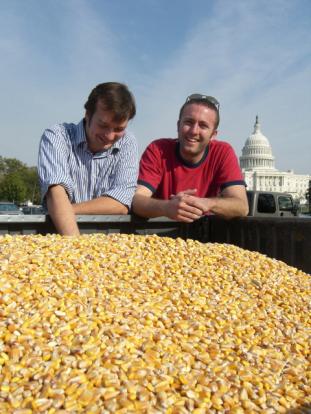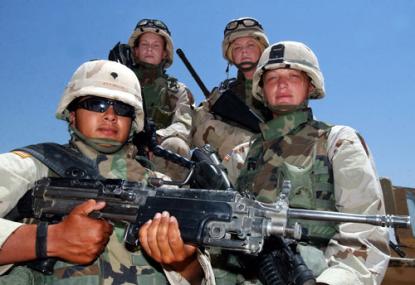Documentary films are changing the world. From the global warming warnings of An Inconvenient Truth to Supersize Me’s cautions about our fast food culture and Spike Lee’s study of Hurricane Katrina’s human cost When the Levees Broke, audiences are discovering hidden truths the headlines can’t reveal through the unique character studies and craftsmanship of non-fiction film. A tradition as old as cinema itself, documentary filmmaking has experienced a popular revival in recent years marked most notably by the 2004 success of Michael Moore’s polemic on the Iraq War, Fahrenheit 9/11. Examinations of the war are not the only projects fueling this revival; films on the environment, racism, religion, and more are finding audiences on television, in theaters, and in church basements. Many of these projects measure their success, not by DVD sales, but by their ability to create social change. But can documentary films shift someone’s attitudes or behaviors? Do they really change hearts and minds?
One way to answer this question is to consider the hard data. By tallying the number of festivals, awards, web hits, DVD sales, theatrical screenings, broadcasts and reviews, a picture of how many people have seen a film, and their general reaction to it, begins to emerge. Even more precise details come to light using tools like Google Analytics which can track whether a broadcast in Michigan drove traffic from that state to a film’s website. This quantitative data can give a very general sense of impact, but the data is limited and doesn’t reveal how audiences are engaging with the material, and if the film makes a difference in their lives.
“We believe it does make a difference. That’s why we do what we do,” says Simon Kilmurry, Executive Director of P.O.V., television's longest-running showcase for independent non-fiction films. “However, it’s difficult to measure changes when much of the information is anecdotal.” In a survey they conducted of attendees at P.O.V. community screenings across the U.S., the P.O.V. team discovered that 80% of survey respondents felt they had a deeper understanding of the issues explored in the film. While 63% reported that they felt “inspired to act” due to what they learned, only 22% followed up with suggested Take Action opportunities. “Attitudes can change, understanding of an issue may deepen, but getting people to move to action is always a bit more difficult,” Kilmurry noted.
Those films that have measurably demonstrated an ability to make a significant difference beyond the cinemaplex are those with robust and focused outreach plans. One such project is King Corn. A film by Aaron Wolf, Ian Cheney, and Curt Ellis, King Corn is a documentary about agricultural policy, farming, and food from the filmmakers’ perspective as they attempt to raise one acre of corn. Using the traditional indicators of a film’s success, King Corn did exceptionally well. It appeared at film festivals around the globe, won several awards, and played to 1.2 million viewers during its television premiere on PBS’s Independent Lens (the highest ever recorded for the show). However, they knew if they were going to make the issues facing farmers important to the general public, they needed to reach beyond those inclined to see the film on their own.
In a 2007 study titled Documentaries on a Mission, scholar Matt Nisbet suggests that the bulk of the documentary audiences are “the choir,” a group of people watching films that cater to their “pre-existing social views.” He offers that one way a film can get beyond the choir and on the public agenda is by providing a news hook: “Documentary films…have a strong influence as media agenda-setters. Films provide dramatic ‘news pegs’ for journalists seeking to either sustain or generate new coverage of an issue.” In King Corn’s ambitious press strategy, they pitched stories about the film beyond the entertainment page, and appeared in food sections and business news in papers across the country, and did interviews or placed op-eds in local papers where the film was playing. The filmmakers also appeared on Good Morning, America; CNN; and even made the front page of the Washington Post. By strategically shaping their press strategy not just to promote the film but to draw attention to the issues in the film, the filmmakers engaged a national audience on issues of sustainable agriculture regardless of whether or not any of those people actually see the film at all.
Additionally, the King Corn team developed a community screening strategy focused specifically on the Corn Belt, targeting people directly involved with the issues the film explores. “It built our legitimacy,” Ellis remarked. “And it kept us from being perceived as flighty, coastal people who didn’t know what we were talking about.” They found that public forum screenings with opportunities for feedback were effective in luring the more skeptical viewers to see the film, and it built trust within this core constituency of people affected by agricultural policy.
 All of this work for change required more than a group of rag tag filmmakers to get it done. Sheila Leddy of The Fledgling Fund, a foundation supporting media projects focused on issues of social justice, notes, “It takes more than one great film to create change, but a great film can push the movement forward.” Following this logic, the King Corn team connected with grassroots organizations interested in farming issues from the first day of production. Partners included local farmers’ market organizers, the Slow Food movement, and Buy Local coalitions. Some organized free screenings in their community and found ways to link the film to local agricultural issues. Others alerted their networks to screenings, broadcasts, and the DVD release, which significantly boosted audiences and sales, and helped the filmmakers stay on the road bringing their message across the country.
All of this work for change required more than a group of rag tag filmmakers to get it done. Sheila Leddy of The Fledgling Fund, a foundation supporting media projects focused on issues of social justice, notes, “It takes more than one great film to create change, but a great film can push the movement forward.” Following this logic, the King Corn team connected with grassroots organizations interested in farming issues from the first day of production. Partners included local farmers’ market organizers, the Slow Food movement, and Buy Local coalitions. Some organized free screenings in their community and found ways to link the film to local agricultural issues. Others alerted their networks to screenings, broadcasts, and the DVD release, which significantly boosted audiences and sales, and helped the filmmakers stay on the road bringing their message across the country.
Did their multi-tiered, hands-on outreach plan work? King Corn surveyed 35 leaders in the sustainable agriculture movement to find out. Among these leaders, 75% found the film "extremely useful" as an awareness-building tool and 80% found the film "extremely effective in bringing media attention to the issues of food and sustainability". The survey also indicated that leaders felt the film inspired behavioral changes, with 57% convinced that the film could change consumer buying behaviors. Though there aren’t hard numbers to substantiate this claim, Curt Ellis says, “I can’t count any more how many people say they’re changing their diet after seeing the film. Even a year later, they contact us saying they’re staying away from soda and only eat grass-fed beef.”
The film Lioness speaks to the significant impact a project can have through a hyper-focused outreach approach. Directed by Meg McLagan and Daria Sommers, Lioness tells the story of a group of female Army support soldiers active in the first program in American history to send women into direct ground combat. Issues facing women in combat were not the focus of any grassroots organizations at the time, so unlike King Corn, these filmmakers did not have the support of a fully fueled movement behind them.
outreach approach. Directed by Meg McLagan and Daria Sommers, Lioness tells the story of a group of female Army support soldiers active in the first program in American history to send women into direct ground combat. Issues facing women in combat were not the focus of any grassroots organizations at the time, so unlike King Corn, these filmmakers did not have the support of a fully fueled movement behind them.
Their initial goal was to raise public awareness around the challenges women face in the combat arena. In addition to a more traditional distribution strategy, the Lioness team organized events with veterans groups and other grassroots organizations, using these networks as infrastructure for getting the message out about the film. Among these screenings was one at the National Summit for Women Veterans Issues. In attendance was Rep. Susan Davis (D/CA), Chairwoman of the House Armed Services Committee Subcommittee on Military Personnel, who was deeply moved by the film. Her interest sparked a whole new level of outreach for the film, legislators on Capital Hill.
Nine months later, with help from the Disabled Veterans of America, the V.A.’s Center for Women Veterans, and broadcast partner Independent Lens, the team screened a 20 minute excerpt of the film followed by a Q & A with the women soldiers for the House Committee on Veteran Affairs. The room was full of legislators and legislative staffers, veteran advocate organizations, and representatives from the Department of Defense. “It was an electrifying experience for us. All of the people who deal with these issues were there and the film acted as the connective tissue between them,” said filmmaker Daria Sommers. The meeting served to create an agenda of change for women in combat, including the announcement of the Women Veterans Health Care Improvement Bill, a bill designed to solve some of the problems this group identified together.
The Lioness outreach story demonstrates that it’s not always how many people see your film, but who. “The film doesn’t need to be an Academy Award-winning film to make a difference,” Sheila Leddy notes. “Smaller films can be used strategically in the classroom or with key decision makers. If these films could be used to inform those providing services, and help them do their jobs better, that’s huge.”
It’s important to remember that the key to the success of any film is an engaging story. Projects like King Corn and Lioness are effective because they bring issues of social justice to light through the journeys of real people facing real challenges. As Daria Sommers reflected, “In order to galvanize a community, they need to feel connected to the people in the story. That’s the job the film does.” But for that story to make a difference in the world takes more than putting it on a screen. With clear goals, good plans, and the support of an active community of partners, documentary films can contribute to social change.
Photo Credits, from top
King Corn coproducers Curt Ellis and Ian Cheney in Washington DC, photo courtesy of Aaron Wolf, Ian Cheney, and Curt Ellis.
Lionesses Cynthia Espinoza, Ranie Ruthig, Shannon Morgan, and Michelle Perry in Ramadi, Iraq in July 2004. Photograph by Lloyd Francis Jr.


